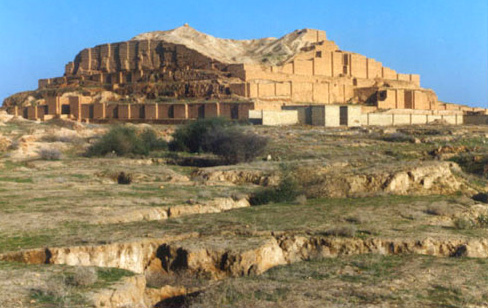12 Jan. Who built the Tower of Babylonia?
"At this time the whole world spoke one language, and everyone used the same words."
"As people moved from the east, they found a plain in the land of Babylonia and settled there. They said to each other, 'Let's make bricks and bake them to make them hard.' So they used bricks instead of stones, and tar instead of mortar."
"Then they said to each other, 'Let's build a city and a [platform] tower [or temple] for ourselves, whose top will reach high into the sky. We will become famous. Then we will not be scattered over all the earth."
"The LORD came down to see the city and the [platform] tower that the people had built. The LORD said, 'Now, these people are united, all speaking the same language. This is only the beginning of what they will do.' "
" 'They will be able to do anything they want. Come, let us go down and confuse their language so they will not be able to understand each other.' "
"So the LORD scattered them from there over all the earth, and they stopped building the city. The place is called Babel since that is where the LORD confused the language of the whole world."
(Genesis 11:1-9)

The author of Genesis records that, in the beginning, there was only one common language which united all the people and made them strong (see Genesis 11:1).
In time, God became dismayed that these headstrong people were building a ‘tower’ (a 'ziggurat' or platform temple) in Babylonia to worship pagan gods, so he decided to scatter the people across the earth and to confuse them with different languages.
The writer explains that the Mesopotamian land of Sumer was later called Babel or Babylon, “since that is where the LORD confused the language of the whole world” (Genesis 11:9). ('Babel' – our word ‘babble’ - sounds like the Hebrew for ‘mixed up’ or ‘confused’.)
As Noah’s descendants moved eastwards across the low-lying floodplain between the Tigris and the Euphrates, they had come to a plain in Shinar (historical Sumer, later called Babylonia, in modern-day southern Iraq). At Eridu (the original Sumerian Nun-ki – the ‘mighty city’ founded by Enoch - see Genesis 4:17-18), near modern-day Basra, the inhabitants made a city out of clay bricks and built a great platform temple (or 'ziggurat') that reached "high into the sky” (Genesis 11:4).
This first religious ‘high place’ in Babylonia, built probably by ‘Nimrod the hunter’ (see Genesis 10:9-12) (who is called ‘King Enmer the hunter’ in the Sumerian Epics) in c.2850BC, was excavated by archaeologists in the 1940s. It was dedicated to Enki, the god of wisdom.
This first 'Tower of Babylonia' at Eridu was later joined by many other Babylonian ‘towers’ – step-pyramids or ‘ziggurats’ with small temples on top honouring the local gods. They were built higher than other buildings as the gods were assumed to dwell in the highest places. In practical terms, it also raised them well above the level of flooding on the surrounding low-lying Mesopotamian floodplain.
The ziggurat of the ancient city of Babylon itself, built in c.1700BC (and called the 'Etemenanki' in Sumerian, meaning ‘temple of the foundation of heaven and earth’) is often confused with the earlier Biblical 'Tower of Babel' or 'Tower of Babylonia' built over a thousand years earlier at Eridu (see Genesis 11:2-8).
The photo (by Zereshk) shows the remains of Choghazanbil ziggurat. Built in the 13th century BC, it's one of the world's best preserved ziggurats, located near Susa in Iran.
You can read more about the Tower of Babylonia @ https://www.thebiblejourney.org/biblejourney2/23-the-journeys-of-adam-enoch-noah-abraham/the-tower-of-babylonia/
